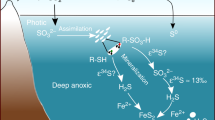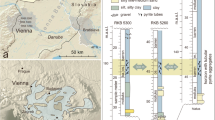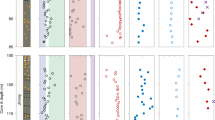Abstract
Geochemical data from ancient sedimentary successions provide evidence for the progressive evolution of Earth’s atmosphere and oceans1,2,3,4,5,6,7. Key stages in increasing oxygenation are postulated for the Palaeoproterozoic era (∼2.3 billion years ago, Gyr ago) and the late Proterozoic eon (about 0.8 Gyr ago), with the latter implicated in the subsequent metazoan evolutionary expansion8. In support of this rise in oxygen concentrations, a large database1,2,3,9 shows a marked change in the bacterially mediated fractionation of seawater sulphate to sulphide of Δ34S < 25‰ before 1 Gyr to ≥50‰ after 0.64 Gyr. This change in Δ34S has been interpreted to represent the evolution from single-step bacterial sulphate reduction to a combination of bacterial sulphate reduction and sulphide oxidation, largely bacterially mediated3,7,9. This evolution is seen as marking the rise in atmospheric oxygen concentrations and the evolution of non-photosynthetic sulphide-oxidizing bacteria3,7,10. Here we report Δ34S values exceeding 50‰ from a terrestrial Mesoproterozoic (1.18 Gyr old) succession in Scotland, a time period that is at present poorly characterized. This level of fractionation implies disproportionation in the sulphur cycle, probably involving sulphide-oxidizing bacteria, that is not evident from Δ34S data in the marine record1,2,3,9. Disproportionation in both red beds and lacustrine black shales at our study site suggests that the Mesoproterozoic terrestrial environment was sufficiently oxygenated to support a biota that was adapted to an oxygen-rich atmosphere, but had also penetrated into subsurface sediment.
This is a preview of subscription content, access via your institution
Access options
Subscribe to this journal
Receive 51 print issues and online access
$199.00 per year
only $3.90 per issue
Buy this article
- Purchase on Springer Link
- Instant access to full article PDF
Prices may be subject to local taxes which are calculated during checkout




Similar content being viewed by others
References
Canfield, D. E. & Teske, A. Late Proterozoic rise in atmospheric oxygen concentration inferred from phylogenetic and sulphur-isotope studies. Nature 382, 127–132 (1996)
Canfield, D. E. A new model for Proterozoic ocean chemistry. Nature 396, 450–453 (1998)
Canfield, D. E. The evolution of the Earth surface sulfur reservoir. Am. J. Sci. 304, 839–861 (2004)
Bekker, A. et al. Dating the rise of atmospheric oxygen. Nature 427, 117–120 (2004)
Fike, D. A., Grotzinger, J. P., Pratt, L. M. & Summons, R. E. Oxidation of the Ediacaran Ocean. Nature 444, 744–747 (2006)
Scott, C. et al. Tracing the stepwise oxygenation of the Proterozoic ocean. Nature 452, 456–459 (2008)
Lyons, T. W. & Gill, B. C. Ancient sulfur cycling and oxygenation of the early biosphere. Elements 6, 93–99 (2010)
Runnegar, B. Precambrian oxygen levels estimated from the biochemistry and physiology of early eukaryotes. Palaeogeogr. Palaeoclimatol. Palaeoecol. 97, 97–111 (1991)
Canfield, D. E. & Raiswell, R. The evolution of the sulfur cycle. Am. J. Sci. 299, 697–723 (1999)
Johnston, D. T., Farquhar, J. & Canfield, D. E. Sulfur isotope insights into microbial sulphate reduction: when microbes meet models. Geochim. Cosmochim. Acta 71, 3929–3947 (2007)
Wortmann, U., Bernasconi, S. M. & Böttcher, M. E. Hypersulfidic deep biosphere indicates extreme sulfur isotope fractionation during single-step microbial sulfate reduction. Geology 29, 647–650 (2001)
Lyons, T. C., Kah, L. C. & Gellatly, A. M. in The Precambrian Earth: Tempos and Events (eds Eriksson, P. G., Altermann, W., Nelson, D. R., Mueller, W. U. & Catuneanu, O.) 421–440 (Elsevier, 2004)
Hurtgen, M. T., Arthur, M. A. & Halverson, G. P. Neoproterozoic sulfur isotopes, the evolution of microbial sulfur species, and the burial efficiency of sulphide as sedimentary pyrite. Geology 33, 41–44 (2005)
Johnston, D. T. et al. Active microbial sulfur disproportionation in the Mesoproterozoic. Science 310, 1477–1479 (2005)
Kah, L. C., Lyons, T. W. & Chesley, J. T. Geochemistry of a 1.2 Ga carbonate-evaporite succession, northern Baffin and Bylot Islands: implications for Mesoproterozoic marine evolution. Precambr. Res. 111, 203–234 (2001)
Stewart, A. D. The later Proterozoic Torridonian rocks of Scotland: their sedimentology, geochemistry and origin. Geol. Soc. Mem. No. 24, (2002)
Prave, A. R. Life on land in the Proterozoic: evidence from the Torridonian rocks of northwest Scotland. Geology 30, 811–814 (2002)
Fry, B., Giblin, A., Dornblaser, M. & Peterson, B. in Geochemical Transformations of Sedimentary Sulfur (eds Vairavamurthy, A. & Schoonens, M. A. A.) 397–410 (American Chemical Society, 1995)
Turnbull, M. J. M., Whitehouse, M. J. & Moorbath, S. New isotopic age determinations for the Torridonian, NW Scotland. J. Geol. Soc. Lond. 153, 955–964 (1996)
Darabi, M. H. & Piper, J. D. A. Palaeomagnetism of the (Late Mesoproterozoic) Stoer Group, Northwest Scotland: implications for diagenesis, age and relationship to the Grenville Orogeny. Geol. Mag. 141, 15–39 (2004)
Amor, K., Hesselbo, S. P., Porcelli, D., Thackrey, S. & Parnell, J. A Precambrian proximal ejecta blanket from Scotland. Geology 36, 303–306 (2008)
Strauss, H. The sulfur isotopic record of Precambrian sulfates: new data and a critical evaluation of the existing record. Precambr. Res. 63, 225–246 (1993)
Sillitoe, R. H., Folk, R. L. & Saric, N. Bacteria as mediators of copper sulfide enrichment during weathering. Science 272, 1153–1155 (1996)
Lowry, D., Boyce, A. J., Fallick, A. E., Stephens, W. E. & Grassineau, N. V. Terrane and basement discrimination in northern Britain using sulphur isotopes and mineralogy of ore deposits. Geol. Soc. Lond. Spec. Publ. 248, 133–151 (2005)
Machel, H. G. Bacterial and thermochemical sulphate reduction in diagenetic settings — old and new insights. Sedim. Geol. 140, 143–175 (2001)
Johnston, D. T., Wolfe-Simon, F., Pearson, A. & Knoll, A. H. Anoxygenic photosynthesis modulated Proterozoic oxygen and sustained Earth’s middle age. Proc. Natl Acad. Sci. USA 106, 16925–16929 (2009)
Poulton, S. W., Fralick, P. W. & Canfield, D. E. Spatial variability in oceanic redox structure 1.8 billion years ago. Nature Geosci. 3, 486–490 (2010)
Robinson, B. W. & Kusakabe, M. Quantitative preparation of sulfur dioxide for 34S/32S analyses from sulphides by combustion with cuprous oxide. Anal. Chem. 47, 1179–1181 (1975)
Coleman, M. L. & Moore, M. P. Direct reduction of sulphates to sulphur dioxide for isotopic analysis. Anal. Chem. 28, 199–260 (1978)
Wagner, T., Boyce, A. J. & Fallick, A. E. Laser combustion analysis of δ34S of sulfosalt minerals: determination of the fractionation systematics and some crystal-chemical considerations. Geochim. Cosmochim. Acta 66, 2855–2863 (2002)
Acknowledgements
We thank D. Fike for criticism of the manuscript; J. Still, J. B. Fulton and C. W. Taylor for technical help. S.S. is funded by the University of Aberdeen. NERC provides funding for the Argon Isotope and Isotope Community Support Facilities, and SUERC is financially supported by the Scottish Universities Consortium.
Author information
Authors and Affiliations
Contributions
J.P. directed the research; A.J.B. performed sulphur isotope analysis; D.M. performed Ar/Ar dating; J.P, S.B. and S.S. undertook field sampling; S.S. and S.B. performed petrographic analysis; J.P, A.B. and D.M. wrote the paper. All authors discussed the results and commented on the manuscript.
Corresponding author
Ethics declarations
Competing interests
The authors declare no competing financial interests.
Supplementary information
Supplementary Information
This file contains Stoer Group summary and references, Stac Fada Member summary, Ar/Ar methods, Ar/Ar brief discussion and references, Raw Ar/Ar data and step-heating spectrum with inverse and normal isochron plots, Raw sulphur isotope data, diagenetic sulphides and Raw sulphur isotope data, cross-cutting sulphides. (PDF 1003 kb)
Rights and permissions
About this article
Cite this article
Parnell, J., Boyce, A., Mark, D. et al. Early oxygenation of the terrestrial environment during the Mesoproterozoic. Nature 468, 290–293 (2010). https://doi.org/10.1038/nature09538
Received:
Accepted:
Published:
Issue Date:
DOI: https://doi.org/10.1038/nature09538
This article is cited by
-
Precambrian and early Cambrian palaeobiology of India: Quo Vadis
Proceedings of the Indian National Science Academy (2021)
-
High Molybdenum availability for evolution in a Mesoproterozoic lacustrine environment
Nature Communications (2015)
-
Elemental sulfur in northern South China Sea sediments and its significance
Science China Earth Sciences (2015)
-
Enhanced cellular preservation by clay minerals in 1 billion-year-old lakes
Scientific Reports (2014)
-
Geomicrobial functional groups: A window on the interaction between life and environments
Chinese Science Bulletin (2012)
Comments
By submitting a comment you agree to abide by our Terms and Community Guidelines. If you find something abusive or that does not comply with our terms or guidelines please flag it as inappropriate.



